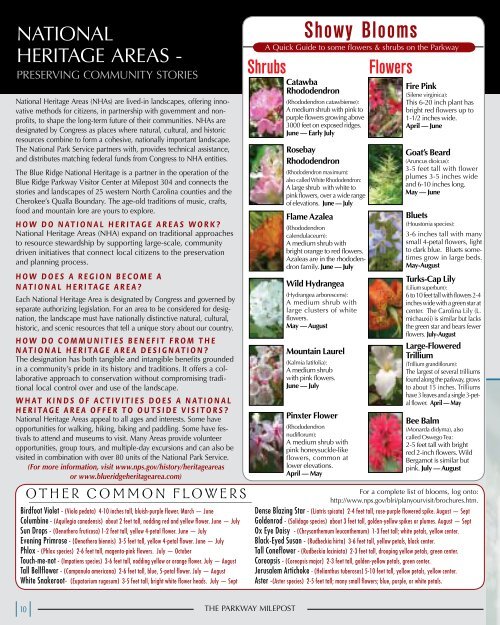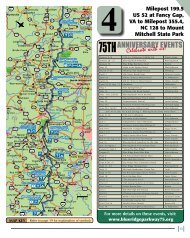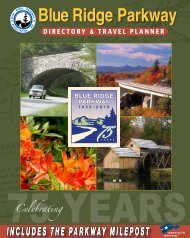Blue Ridge Park way - Massanutten Resort
Blue Ridge Park way - Massanutten Resort
Blue Ridge Park way - Massanutten Resort
Create successful ePaper yourself
Turn your PDF publications into a flip-book with our unique Google optimized e-Paper software.
NATIONAL<br />
HERITAGE AREAS -<br />
PRESERVING COMMUNITY STORIES<br />
National Heritage Areas (NHAs) are lived-in landscapes, offering innovative<br />
methods for citizens, in partnership with government and nonprofits,<br />
to shape the long-term future of their communities. NHAs are<br />
designated by Congress as places where natural, cultural, and historic<br />
resources combine to form a cohesive, nationally important landscape.<br />
The National <strong>Park</strong> Service partners with, provides technical assistance,<br />
and distributes matching federal funds from Congress to NHA entities.<br />
The <strong>Blue</strong> <strong>Ridge</strong> National Heritage is a partner in the operation of the<br />
<strong>Blue</strong> <strong>Ridge</strong> <strong>Park</strong><strong>way</strong> Visitor Center at Milepost 304 and connects the<br />
stories and landscapes of 25 western North Carolina counties and the<br />
Cherokee’s Qualla Boundary. The age-old traditions of music, crafts,<br />
food and mountain lore are yours to explore.<br />
How Do NATIoNAl HerITAGe AreAs work?<br />
National Heritage Areas (NHA) expand on traditional approaches<br />
to resource stewardship by supporting large-scale, community<br />
driven initiatives that connect local citizens to the preservation<br />
and planning process.<br />
How Does A reGIoN become A<br />
NATIoNAl HerITAGe AreA?<br />
Each National Heritage Area is designated by Congress and governed by<br />
separate authorizing legislation. For an area to be considered for designation,<br />
the landscape must have nationally distinctive natural, cultural,<br />
historic, and scenic resources that tell a unique story about our country.<br />
H o w D o c o m m u N I T I e s b e N e F I T F r o m T H e<br />
NATIoNAl HerITAGe AreA DesIGNATIoN?<br />
The designation has both tangible and intangible benefits grounded<br />
in a community’s pride in its history and traditions. It offers a collaborative<br />
approach to conservation without compromising traditional<br />
local control over and use of the landscape.<br />
w H A T k I N D s o F A c T I v I T I e s D o e s A N A T I o N A l<br />
HerITAGe AreA oFFer To ouTsIDe vIsITors?<br />
National Heritage Areas appeal to all ages and interests. Some have<br />
opportunities for walking, hiking, biking and paddling. Some have festivals<br />
to attend and museums to visit. Many Areas provide volunteer<br />
opportunities, group tours, and multiple-day excursions and can also be<br />
visited in combination with over 80 units of the National <strong>Park</strong> Service.<br />
(For more information, visit www.nps.gov/history/heritageareas<br />
or www.blueridgeheritagearea.com)<br />
Other COmmOn FlOwers<br />
Birdfoot Violet - (Viola pedata) 4-10 inches tall, bluish-purple flower. March — June<br />
Columbine - (Aquilegia canadensis) about 2 feet tall, nodding red and yellow flower. June — July<br />
Sun Drops - (Oenothera fruticosa) 1-2 feet tall, yellow 4-petal flower. June — July<br />
Evening Primrose - (Oenothera biennis) 3-5 feet tall, yellow 4-petal flower. June — July<br />
Phlox - (Phlox species) 2-6 feet tall, magenta-pink flowers. July — October<br />
Touch-me-not - (Impatiens species) 3-6 feet tall, nodding yellow or orange flower. July — August<br />
Tall Bellflower - (Campanula americana) 2-6 feet tall, blue, 5-petal flower. July — August<br />
White Snakeroot- (Eupatorium rugosum) 3-5 feet tall, bright white flower heads. July — Sept<br />
10<br />
Showy Blooms<br />
Shrubs Flowers<br />
THE PARKWAY MILEPOST<br />
A Quick Guide to some flowers & shrubs on the <strong>Park</strong><strong>way</strong><br />
Catawba<br />
Rhododendron<br />
(Rhododendron catawbiense):<br />
A medium shrub with pink to<br />
purple flowers growing above<br />
3000 feet on exposed ridges.<br />
June — Early July<br />
Rosebay<br />
Rhododendron<br />
(Rhododendron maximum):<br />
also called White Rhododendron:<br />
A large shrub with white to<br />
pink flowers, over a wide range<br />
of elevations. June — July<br />
Flame Azalea<br />
(Rhododendron<br />
calendulaceum):<br />
A medium shrub with<br />
bright orange to red flowers.<br />
Azaleas are in the rhododendron<br />
family. June — July<br />
Wild Hydrangea<br />
(Hydrangea arborescens):<br />
A medium shrub with<br />
large clusters of white<br />
flowers.<br />
May — August<br />
Mountain Laurel<br />
(Kalmia latifolia):<br />
A medium shrub<br />
with pink flowers.<br />
June — July<br />
Pinxter Flower<br />
(Rhododendron<br />
nudiflorum):<br />
A medium shrub with<br />
pink honeysuckle-like<br />
flowers, common at<br />
lower elevations.<br />
April — May<br />
Fire Pink<br />
(Silene virginica):<br />
This 6-20 inch plant has<br />
bright red flowers up to<br />
1-1/2 inches wide.<br />
April — June<br />
Goat’s Beard<br />
(Aruncus dioicus):<br />
3-5 feet tall with flower<br />
plumes 3-5 inches wide<br />
and 6-10 inches long.<br />
May — June<br />
<strong>Blue</strong>ts<br />
(Houstonia species):<br />
3-6 inches tall with many<br />
small 4-petal flowers, light<br />
to dark blue. <strong>Blue</strong>ts sometimes<br />
grow in large beds.<br />
May-August<br />
Turks-Cap Lily<br />
(Lilium superbum):<br />
6 to 10 feet tall with flowers 2-4<br />
inches wide with a green star at<br />
center. The Carolina Lily (L.<br />
michauxii) is similar but lacks<br />
the green star and bears fewer<br />
flowers. July-August<br />
Large-Flowered<br />
Trillium<br />
(Trillium grandiflorum):<br />
The largest of several trilliums<br />
found along the park<strong>way</strong>, grows<br />
to about 15 inches. Trilliums<br />
have 3 leaves and a single 3-petal<br />
flower. April — May<br />
Bee Balm<br />
(Monarda didyma), also<br />
called Oswego Tea:<br />
2-5 feet tall with bright<br />
red 2-inch flowers. Wild<br />
Bergamot is similar but<br />
pink. July — August<br />
For a complete list of blooms, log onto:<br />
http://www.nps.gov/blri/planyourvisit/brochures.htm.<br />
Dense Blazing Star - (Liatris spicata) 2-4 feet tall, rose-purple flowered spike. August — Sept<br />
Goldenrod - (Solidago species) about 3 feet tall, golden-yellow spikes or plumes. August — Sept<br />
Ox Eye Daisy - (Chrysanthemum leucanthemum) 1-3 feet tall; white petals, yellow center.<br />
Black-Eyed Susan - (Rudbeckia hirta) 3-6 feet tall, yellow petals, black center.<br />
Tall Coneflower - (Rudbeckia laciniata) 2-3 feet tall, drooping yellow petals, green center.<br />
Coreopsis - (Coreopsis major) 2-3 feet tall, golden-yellow petals, green center.<br />
Jerusalem Artichoke - (Helianthus tuberosus) 5-10 feet tall, yellow petals, yellow center.<br />
Aster -(Aster species) 2-5 feet tall; many small flowers; blue, purple, or white petals.








